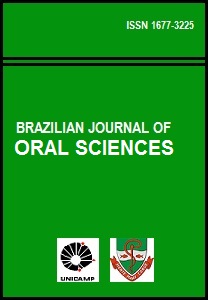Abstract
Healing tissues of extraction sockets have been used, as autografts, for the treatment of periodontal bony defects. These tissues have proved to be more effective in inducing bone formation than mature bone. However, there are limited data regarding the nature and proliferative activity of its cells. The aim of this pilot study was to analyze the nature and the proliferative activity of cells present in newly formed tissue from human extraction sockets, covered or not by an e-PTFE membrane. The healing tissue of 6 pairs from human alveolar sockets covered or not by an e-PTFE membrane, collected 4 weeks after tooth extraction was analyzed. The specimens were observed using light and transmission electron microscopy (TEM). The immunohistochemical characterization of the tissues included type I collagen, osteonectin and bone sialoprotein detection. The proliferation rates of the tissues were obtained using PCNA labeling. Cells and extracellular matrix were labeled for type I collagen, osteonectin and bone sialoprotein, in both groups. PCNA antibodies revealed significant higher proliferation rates in the coronal areas than in the apical areas of the tissues, independent of which group they belonged to. TEM showed cells containing a Golgi apparatus, rough endoplasmic reticulum and mitochondria indicative of secretory cells, in both groups. In the apical area of the test and control groups, the extracellular matrix exhibited more bundles of collagen fibrils than in the coronal area. The cells of healing tissue of dental sockets are osteoblastic in nature. Additionally, they present higher proliferating rates in the coronal areas, independent of the use of the e-PTFE membrane.References
Schenk R K. Bone regeneration: biologic basis. In: Buser D, Dahlin C, Schenk RK, editors. Guided bone regeneration in implant dentistry. Hong Kong: Quintessence; 1994. p.49-100.
Dahlin C. Scientific background of guided bone regeneration. In: Buser D, Dahlin C, Schenk RK, editors. Guided bone regeneration in implant dentistry. Hong Kong: Quintessence; 1994. p.31-48.
Seibert JS. Treatment of moderate localized alveolar ridge defects. Dent Clin North Am 1993; 37: 265-80.
O’Brien TP, Hinrichs JE, Schaffer EM. The prevention of localized ridge deformities using guided tissue regeneration. J Periodontol 1994; 65: 17-24.
Lekovic V, Kenney EB, Weinlaender M, Han T, Klokkevold P, Nedic M, Orsini M. A bone regenerative approach to alveolar ridge maintenance following tooth extraction. Report of 10 cases. J Periodontol 1997; 68: 563–70.
Hardwick R, Scantlebury T V, Sanchez R, Whitely N, Ambruster J. Membrane design criteria for guided bone regeneration of the alveolar ridge. In: Buser D, Dahlin C, Schenk RK, editors. Guided bone regeneration in implant dentistry. Hong Kong: Quintessence; 1994: p.b101-136.
Evian CI, Rosenberg ES, Coslet JG, Corn H. The osteogenic activity of bone removed from healing extraction sockets in humans. J Periodontol 1982; 53: 81-5.
Passanezi E, Janson WA, Nahas D, Campos Junior A. Newly forming bone autografts to treat periodontal infrabony pockets: clinical and histological events. Int J Periodontics Restorative Dent 1989; 9: 140-53.
Amler MH. The effectiveness of regenerating versus mature marrow in physiologic autogenous transplants. J Periodontolol 1984; 55: 268-72.
Nowzari H, Matian F, Slots J. Periodontal pathogens on polytetrafluoroethylene membrane for guided tissue regeneration inhibit healing. J Clin Periodontol 1995; 22: 469-74.
Veksler AE, Kayrouz GA, Newmann MG. Reduction of salivary bacteria by pre-procedural rinses with chlorhexidine 0.12%. J Periodontol 1991; 62: 649-51.
Addy M, Renton-Harper P. The role of antiseptics in secondary prevention. In: Lang N P, Karring T, Lindhe J, editors. Proceedings of the 2nd European Workshop on Periodontology: chemicals in periodontics. Berlin: Quintessence; 1997. p.152- 73.
Becker W, Becker BE. Bone promotion around e-PTFEaugmented implants placed in immediate extraction sockets. In: Buser D, Dahlin C, Schenk RK, editors. Guided bone regeneration in implant dentistry. Hong Kong: Quintessence; 1994. p.137-54.
Mellonig JT, Triplett RG. Guided tissue regeneration and endosseous dental implants. Int J Periodontics Restorative Dent 1993; 13: 109-19.
Becker W, Becker BE. Guided tissue regeneration for implants placed into extraction sockets and for implant dehiscences: surgical techniques and case reports. Int J Periodontics Restorative Dent 1990; 10: 377-91.
Newell DH, Brunsvold MA. A modification of the “Curtain Technique” incorporating an internal mattress suture. J Periodontol 1985; 56: 484–7.
Mellonig JT, Nevins M. Guided bone regeneration and dental implants. In: Mellonig JT, Nevins M, editors. Implant Therapy: clinical approaches and evidence of success. Japan: Quintessence; 1998. vol.2, p.53-82.
Devlin H, Sloan P. Early bone healing events in the human extraction socket. Int J Oral Maxillofac Surg 2002; 31: 641-5.
The Brazilian Journal of Oral Sciences uses the Creative Commons license (CC), thus preserving the integrity of the articles in an open access environment.

